
|   |

|   |
Harina abhisarana: Splendor of the river, the forest and Ramayana - Poornima Ramaprasad e-mail: poornima@sbcglobal.net Photos: Sree Sripathy May 8, 2011 As the river Godavari unfolded in all its grandeur at the Woodside High School Auditorium in Woodside, CA, on 30th April 2011 as part of the Vasantha Sahityotsava of the Kannada Sahitya Ranga, the Bay area art and literature connoisseurs got ready for a visual treat. The depth and breadth of the river was seen in its entirety as the dancers, clad in white and blue serene costumes came up with some seamless formations and footwork depicting the flow of the river. They danced with high energy bringing out the mood of the river, carrying away everyone to the banks of the Godavari. 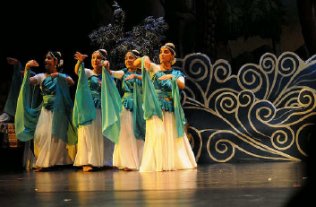  The carefully composed chorus akarams in the raga Valachi for the quiet waves, Kedara for the dexterity and Desh for the calming evening waves, along with the complete ensemble of flute, violin, veena and mridangam was heavenly. The setting was perfect with a small hay hut and a backdrop of a forest with some wild flowers. Totally, a magnificent build-up was given to the musical "Harina-abhisarana"(Fondly behind a beloved deer) by the legendary poet of Karnataka, Dr. Pu.Thi.Na. This was produced by the late poet's daughter and Bay area's talented dramatist Alamelu Iyengar. 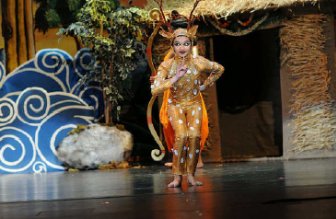 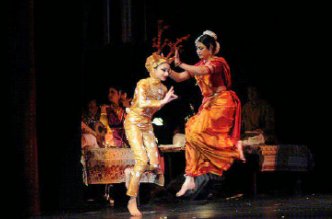 On the banks of Godavari at Panchavati, Seetha is happily doing her chores and is enjoying the pleasant surroundings immensely, as a beautiful golden deer captivates her attention. "ago nodu entha harina, baa bega baa bega ramana" (Look at that beautiful deer, come here, come here, O dear) says she. Entranced by its beauty, she pleads with Rama to get it for her. Lakshmana warns Rama and Seetha about its unnaturalness and that it might be another of the Rakshasa tricks. However, Seetha is not convinced and Rama feels obligated to succumb to the wishes of his beloved, who, although a princess, had followed him to the forest. He requests Lakshmana to take care of his sister-in-law while he is away and pursues the deer. 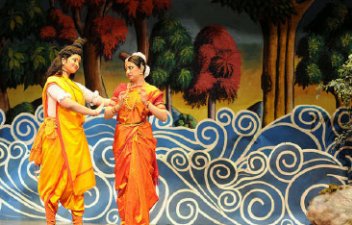 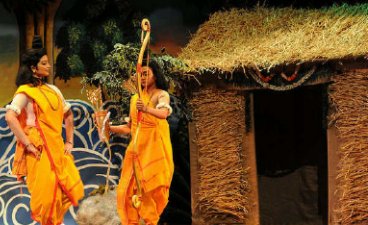 When Rama does not return for a long time, Seetha is worried and has an inkling that Lakshmana was right. But, this time, it is Lakshmana's turn to pacify her saying that he, Raghava, who is all powerful, who is always the 'loka-rakshaka' will never need to worry about being defeated by any mere demon on earth. As they worry, they hear Rama's voice say "Ha Lakshmana, Ha Seetha" and Seetha's worries are intensified. She goes to the point of telling Lakshmana that he wants Rama to perish, so he can get her hand. To this, Lakshmana is upset and leaves to Rama's aid requesting the sun and the moon, the trees and the birds to take care of his sister-in-law.   At his departure, Ravana arrives with the hope of wooing Seetha and making her his. He is disguised as a sage and comes begging for alms. As Seetha pays her respects to him, he reveals his true looks and tries to get hold of her. Seetha cries for help and the play ends with Jatayu's arrival with the flapping of its wings which was done by light effect. 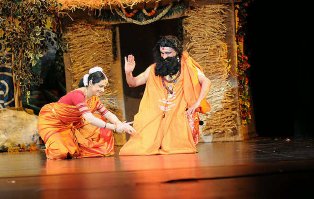 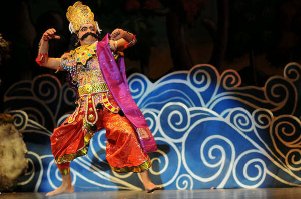 The choreography was by Dr. Tulasi Ramachandra (on a visit to California), an accomplished guru-dancer with an in-depth knowledge and novel perspective towards dance, music and literature. She is the founder and director of Nrityalaya Trust in Mysore. Predominantly, she uses the Vazhuvoor style of Bharatanatyam with her own refinement and calls it "madhurya" (sweetness). This musical's main focus was on abhinaya which was brought out very well by the wonderful dancers Gargi Panchangam as Seetha, Chinmayi Bettadapur as Lakshmana and Chandana Krishnamurthy as Rama. Seetha's feelings of being mesmerized at the sight of the deer, her pangs of sorrow when Rama went missing, her anger when Lakshmana refuses to go leaving her alone, and her helplessness at Ravana's appearance showcased Gargi as a high class dancer. Chinmayi Bettadapur as Lakshmana was very convincing and proved again, that she has grown to be a fine dancer. The arrival of Ravana was depicted with a touch of the Yakshagana style of Karnataka. This was very well handled by the live 'chande' style drumming. Clad in a lovely golden costume, the magical deer was 'very cute' to say the least as it moved back and forth the stage by calculated movements. As per tradition, the musical began with a Pushpanjali and ended with "Mangalam Kausalendraya." 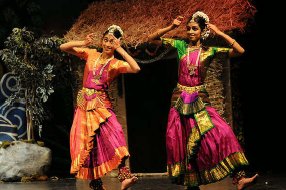 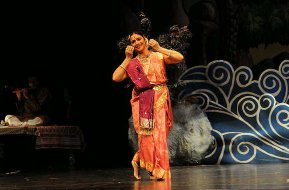 The music direction and the elegant "river flow" composition was by Subhapriya Srivatsan, a prodigy in her own right, with able support from Anil Narasimha, Manudath Gurudatta, Kartik Gopalaratnam, Priya Parameswaran, Harini Krishnan and Gayatri Avvari on vocals. Flute by Mohan Rangan was enchanting, violin by Ajay Narasimha and veena by Mahidhar Tirumala was very apt. Mridangam by the versatile Sriram Brahmanandam of Lalgudi lineage was perfect.  Thanks again, to the illustrious couple Alamelu - Thirunarayana Iyengar, who worked tirelessly to make this happen. An irony when I have to say that Dr. Pu.Thi.Na's literature is so descriptive that one does not need any visuals to visualize and this production was so fine that there was no need for a saahitya to understand. The fact that music and dance are beyond languages was proved yet again. |